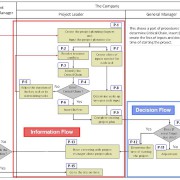8. Building Consensus with Stakeholders (Keita Asaine)
We are continuing to publish articles for the book Theory of Constrains in Practice from the TOC Strategic Solutions Library. It is a collection of cases and articles by TOC experts and practitioners from all around the world sharing their knowledge and experience gained in TOC implementations.
This chapter was written in the period of 2011-2014.
 Dr. Keita Asiane
Dr. Keita Asiane
Dr. Keita Asaine is the President of Juntos Co. Ltd., Japan, and a Founding member of TOCPA – TOC Practitioners Alliance. Keita has TOC experience as a practitioner, trainer and consultant since 2004. He has a Ph.D. in Engineering from Kyushu Institute of Technology (KIT) in Japan. He teaches TOC-TP, Production and Project Management for Masters program at KIT.
http://www.juntos-consulting.com/
Abstract
This article highlights the issues of input availability in Japanese public-work projects, such as late delivery of purchased equipment/materials and missing instructions from customers. These problems cause delays in construction scheduling and increase budget costs which are considered to be the result of a lack of synchronization between procurement activities and process control. In an attempt to overcome a lack of synchronization, the Japanese government runs “One-day Response” initiatives to prevent work stoppages in construction projects.
In Japan, many construction companies engaged in public works have tried to implement CCPM (Critical Chain Project Management) in order to shrink project lead-time and reduce project costs. However, the following comments are often heard from them:
– Some managers follow the procedures of CCPM exactly, but others do not.
– As time passes, after the implementation of CCPM, there is a tendency to revert to previous procedures.
We need to understand the reason why it is difficult to sustain the use of CCPM and how to make it more user-friendly.
We would like to highlight these aspects and share our experience in implementing CCPM. This article looks into how to build consensus within a company in order to continue the use of CCPM, and how to better enable synchronization between procurement activities and process control.
- Introduction
As it is well known, natural disasters such as earthquakes, tsunami, and typhoons occur frequently in Japan. For this reason, the Japanese government has regularly increased the budget for development and maintenance of the country’s infrastructure. However, Figure 1 shows that the budget for public works in Japan has been decreasing since 1996 and this downward trend is expected to continue. Most companies in the construction industry seek to secure the competitive edge needed to shrink project lead-time and reduce costs through more effective construction management [2, 3 and 4].
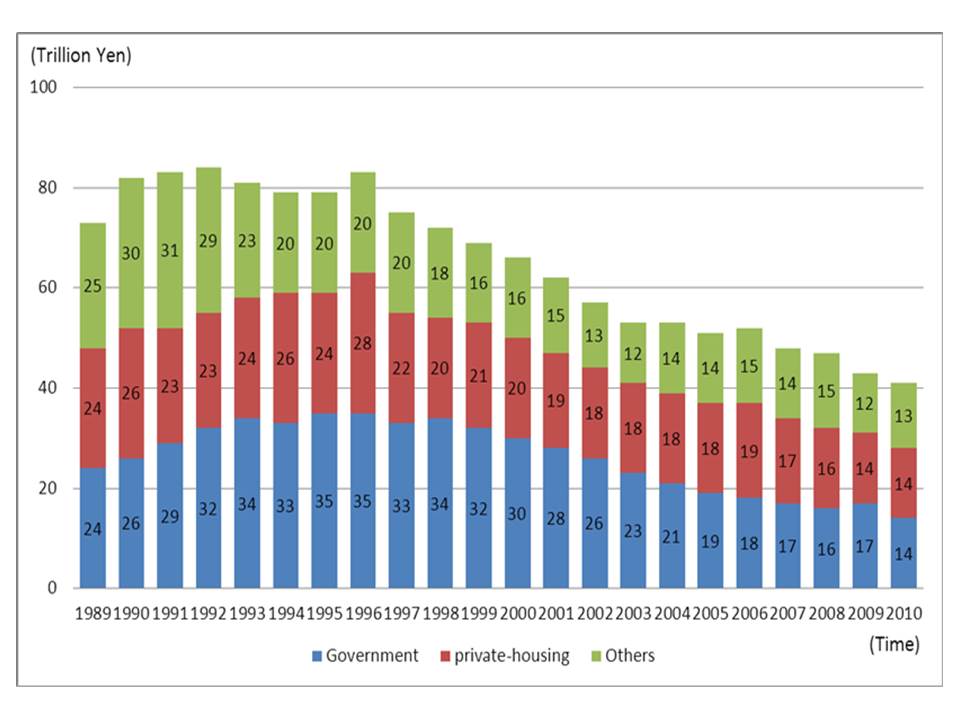
Figure 1: Trend in investment in construction [1]
On the other hand, in order to resolve problems confronting construction projects, constructors need the MLIT (Ministry of Land, Infrastructure, Transport and Tourism) to respond rapidly [5]. Therefore, since 2007, MLIT has been offering “One-day Response” initiatives to authorize activities when problems occur on construction sites [6]. These initiatives are intended to contribute to shrinking construction project lead-times and reducing costs for contractors. Additionally, MLIT asks contractors to create a mechanism to immediately report the impact of the project – scheduling and costs when problems occur. CCPM has supported “One-day Response” initiatives [7, 8 and 9].
In some companies, however, CCPM does not become the established new way of management. Some managers follow CCPM explicitly while others revert to previously employed procedures.
This article investigates the difficulty of continued use of CCPM through a case study.
- Attempts at Implementing CCPM
A Case Study
The company is a sub-contractor in charge of managing workers and procurement of materials and equipment. Their management activities are carried out with the cooperation of contractors.
Figure 2 shows the relationship and roles of each stakeholder. The role of the project manager, who is the client, is to communicate with government and to manage equipment and materials. The role of the project leader is to instruct the work force and to procure resources.
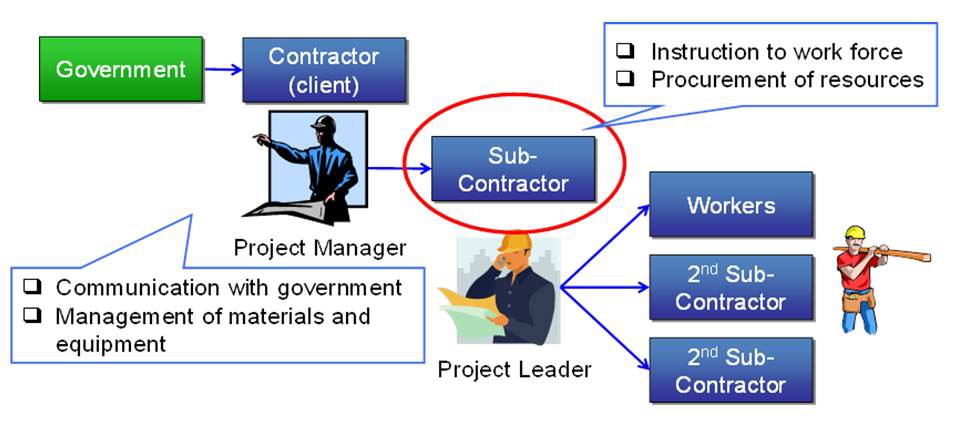
Figure 2: The relationship and roles of each stakeholder
The company has several UDEs (Undesirable Effects) as following:
– There are too many cost overruns
– Many projects take longer than expected
– It is often a struggle to meet deadlines
– Resources (workers, equipment/materials) and inputs are not available when needed.
– Priorities constantly shift
The company implemented CCPM in 2006 in order to resolve the above UDEs. First, the company performed an internal seminar for the general manager and all project leaders in order to learn the software and the essence of CCPM. After that, they developed 3 rules as follows,
At the planning phase:
Rule 1: a project leader makes buffered Critical Chain schedules.
At the execution and control phase:
Rule 2: a project leader obtains the estimation of task completion, updates the software every day, and reports the Buffer Penetration to the general manager.
Rule 3: the general manager makes a decision for recovery actions as needed.
As time passed with the implementation, some project leaders continued to follow the new rules, but others reverted to previous ways. We investigated the reasons why these project leaders stopped following the new rules. At the planning phase, the general manager was always saying “shrink project lead-time” and “reduce costs” without giving actual suggestions and advice. Therefore, the project leaders could not communicate effectively with the project manager concerning schedules and delivering of equipment/materials.
At the execution and control phase, project leaders and the general manager did not know how to manage and make decisions according to the status of buffers. Therefore, the project leaders could not provide clear instructions to workers. Similarly, the general manager could not give instructions and take recovery actions for project leaders. As a result, these project leaders could not achieve shrinking project lead-time and/or reduce costs.
We analyzed the problems outlined above. Project leaders regularly collected information according to the rules. However, project leaders and the general manager did not know how to use this information to make the required managerial decisions. Project leaders could not obtain the desired effects so they stopped following the rules. We found that the procedures and guidelines for management were ambiguous. In addition, the company could not develop clear managerial and operational procedures, as they had been based on the discretion of each project leader.
- Direction to solving the problem
The general manager attended the Goldratt Schools workshop in order to resolve the issues. He learned the TOC solution for single project management [10] – the essence, knowledge, mechanics/procedures and implementation plan of nine CCPM Injections.
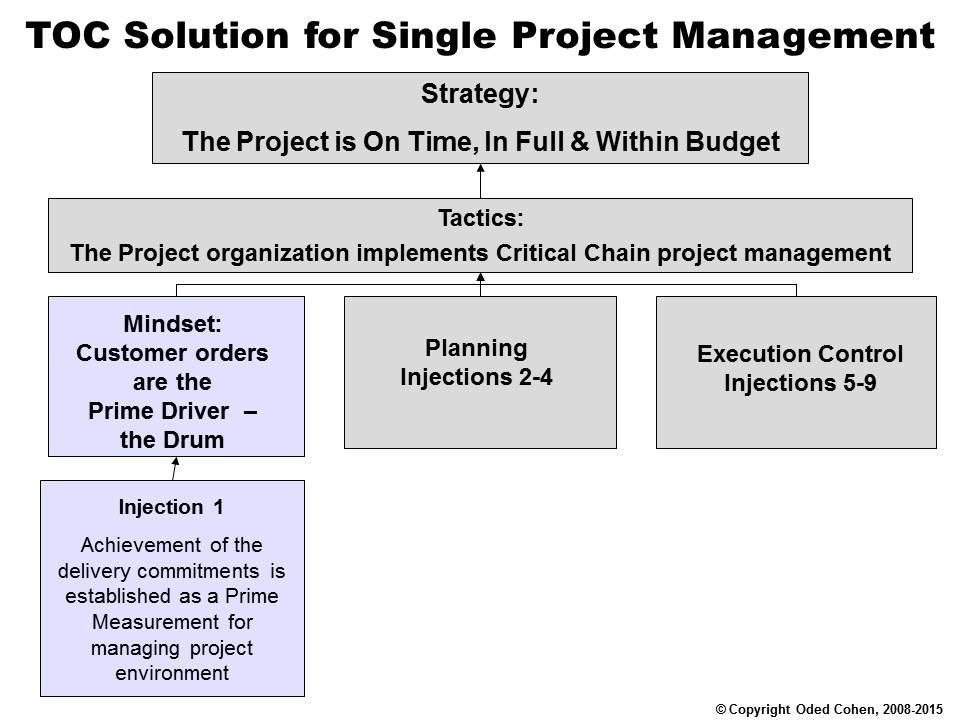
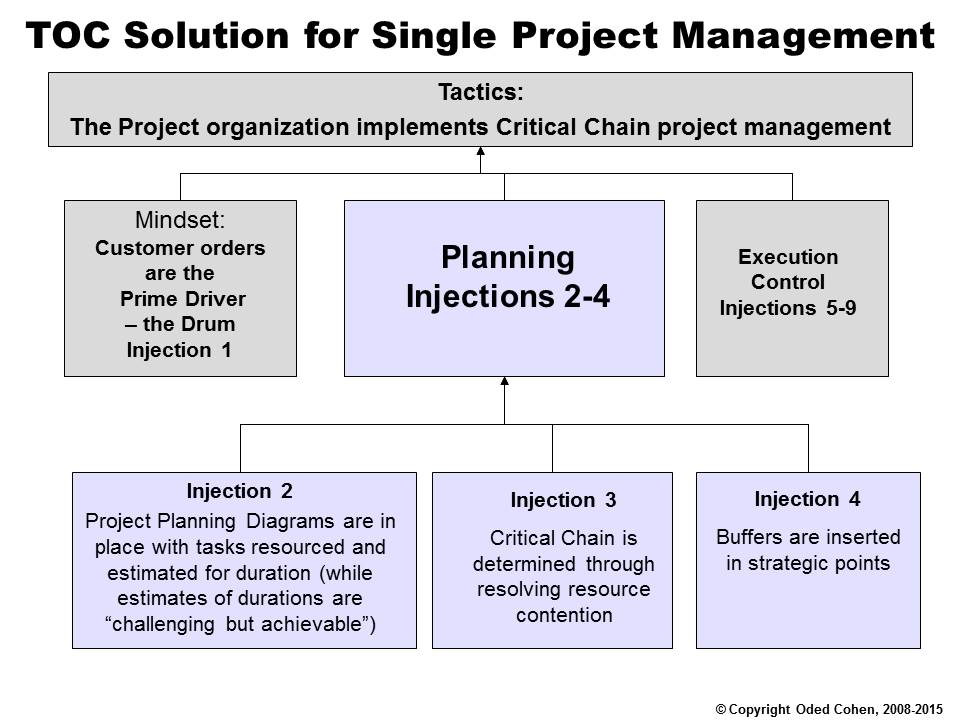
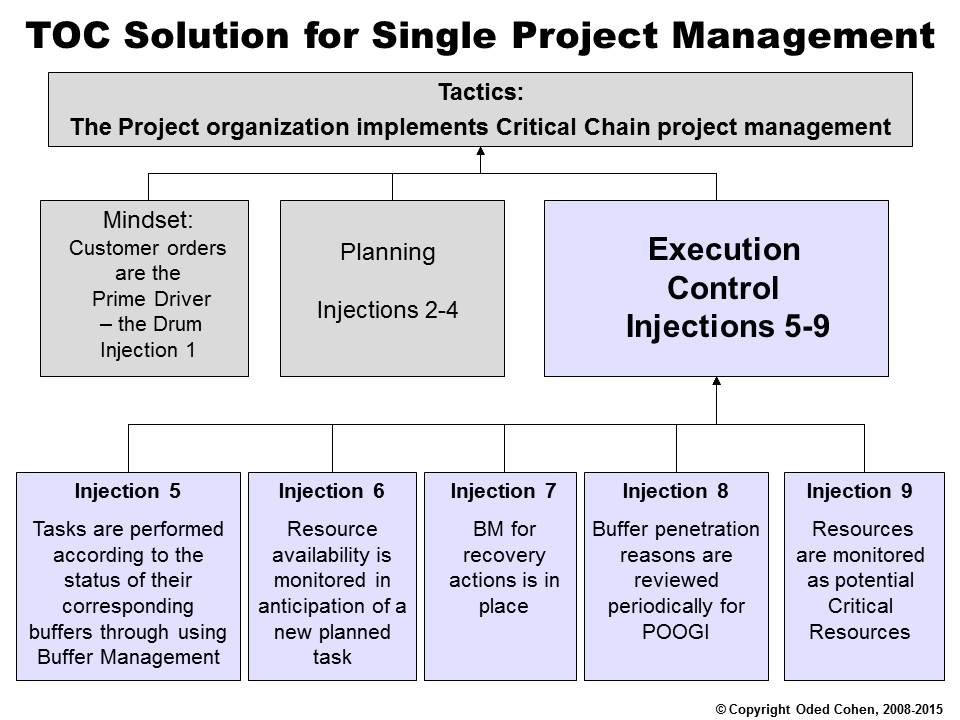
Figure 3: 9 CCPM Injections, presented with the permission by Oded Cohen
After the workshop, the general maanger identified two changing points as follows:
- How to assign and allocate workers to tasks
- How to arrange inputs – equipment/materials and approvals
How to assign and allocate workers to tasks
In the planning phase, the company assigned the same number of workers to all tasks. Actually, the number of workers that should be assigned to each task is different. If the company fixed their number, some tasks would be short of workers. Figure 3 shows a concept of ways to assign workers. If shortages of workers occur for each task, project lead-time is extended. On the other hand, even if there are too many workers for a task, project lead-time is not always shrunk. The workers often wasted time – Parkinson’s Law. As a result, they had too many cost overruns.
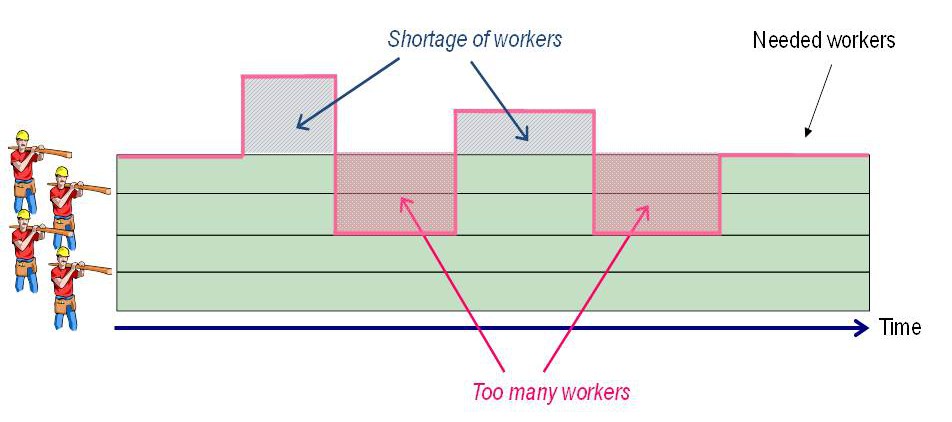
Figure 4: A concept of ways to assign workers
We investigated the reasons why the numbers of workers to all tasks were fixed. The project leader keeps track of the progress of the project, and has to check the current status of the workers needed for the next task and its level of readiness. However, the company did not establish clear procedures and guidelines to accomplish this. Therefore, some project leaders did not secure the workers when needed. Even if they understood procedure and guideline, they did not know how to communicate with 2nd sub-contractors about the need for flexible arrangements of workers.
Afterwards, in order to resolve the above issues, the company established clear procedures and guidelines – the mechanics of wake-up calls for workers (injection 6). After that, top management and the general manager, explained the new procedures to 2nd sub-contractors. Specifically, they developed and built this knowledge together with the 2nd sub-contractors – Problems, Benefits and Risks.
How to arrange inputs – equipment/materials and approvals
The project manager / client usually arranges for materials such as rebar and approvals such as road-use. If the project leader frequently fails to report to the project manager that keeps track of the progress of the project, inputs are not available when needed. As a result, project lead-time is extended, and / or they have too many cost overruns.
We asked all project leaders (the company) and 15 project managers (client) in order to understand current reality about inputs availability. Figure 4 shows the subjective evaluation about inputs availability. We had recognized that project leaders feel dissatisfaction about inputs availability inputs more than project managers. In addition, we interviewed them in order to understand the above issue.
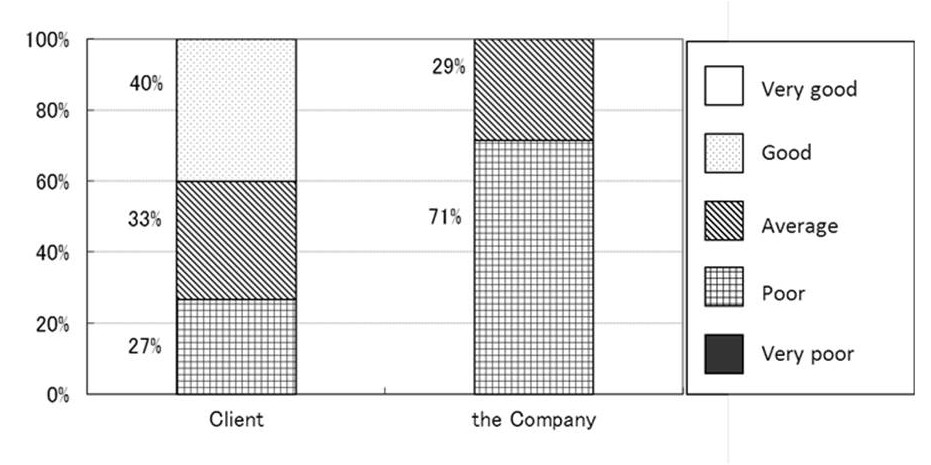
Figure 5: The subjective evaluation about inputs availability
Most project leaders thought that to be operated passively, by following the instructions from the project manager, is the way to match with the customer demand. Therefore, the project leaders had arranged inputs according to the instructions of the project manager. Furthermore, the project leaders kept track of the progress and remaining duration of the project, but they were not able to report it frequently to the project manager. On the other hand, in general, the project managers generally confirmed the current status of the project with the project leader. However, each manager needed different kinds of information to be collected and when the information had to be available. Therefore, many project managers had to make subjective decisions based on intuition and experience rather than actual timely information. To resolve this problem, it was necessary to carry out a “Wake-Up call” initiative, the mechanism to monitor/manage the availability of inputs – equipment and materials, and approvals from the government.
Finally, the project leaders and general manager were able to follow the new technical procedures and mechanics on how to obtain necessary information – call for “Information Flow”. However, even so they did not know how to utilize the information obtained – call for “Decision Flow”. As a result, it became necessary to have new managerial procedures and mechanics. Therefore, the company established the procedures based on “Information Flow” and “Decision Flow”.
- Establishing the Procedure
We investigated the details of the procedure the company established – composed of “Information Flow” and “Decision Flow”.
Planning Phase
Figure 5 shows a part of the procedure for identifying the Critical Chain, inserting Buffers, creating a list of inputs and determining the start date of a project.
A project leader creates a project plan according to “Information Flow” as follows:
[P-1] To create the project planning diagram and input the project plan into software.
- Develop dependency diagram
- Agree upon and record the resources needed for each task
- Estimate task duration, challenging the project leader and agreeing on “challenging but achievable” estimations
[P-2] Resolve resource conflicts.
[P-3] Identify the Critical Chain.
[P-4] Make a decision whether the identified Critical Chain is good or not. The good Critical Chain contains the specific tasks to which the management should pay attention.
[P-5] If the Critical Chain is not acceptable, adjust the duration of the key task or its surrounding tasks. After that, back to resolve the resource conflicts [P-2], again.
[P-6] If it is, insert Buffers.
On the other hand, after creating the project planning diagram [P-1], make an inputs plan as following:
[P-7] Create a lists of inputs needed for each task.
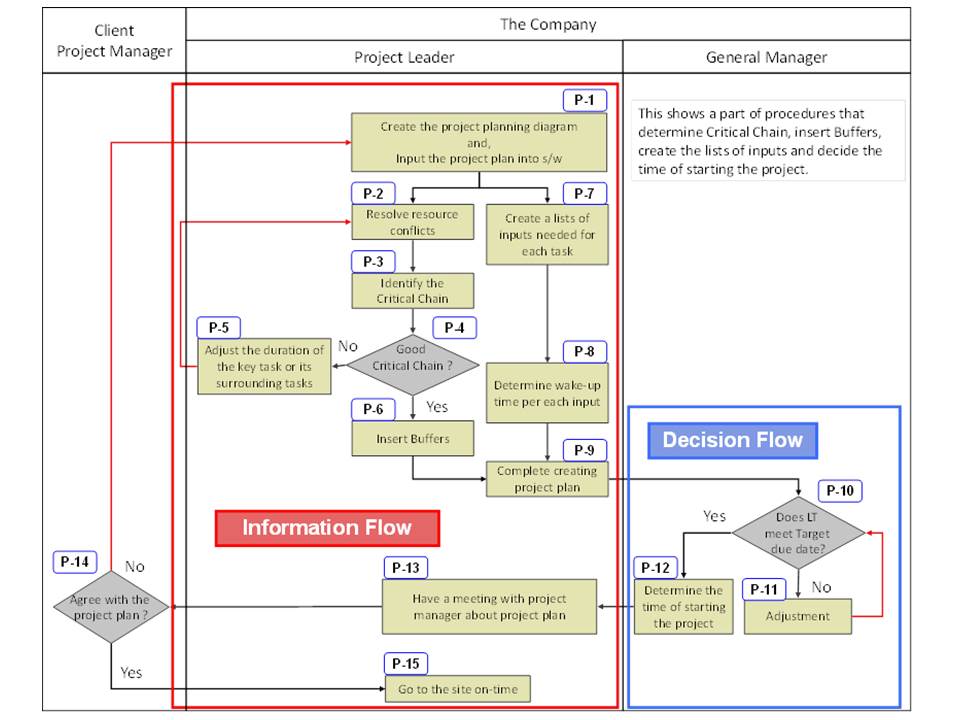
Figure 6: A part of procedures in the planning phase
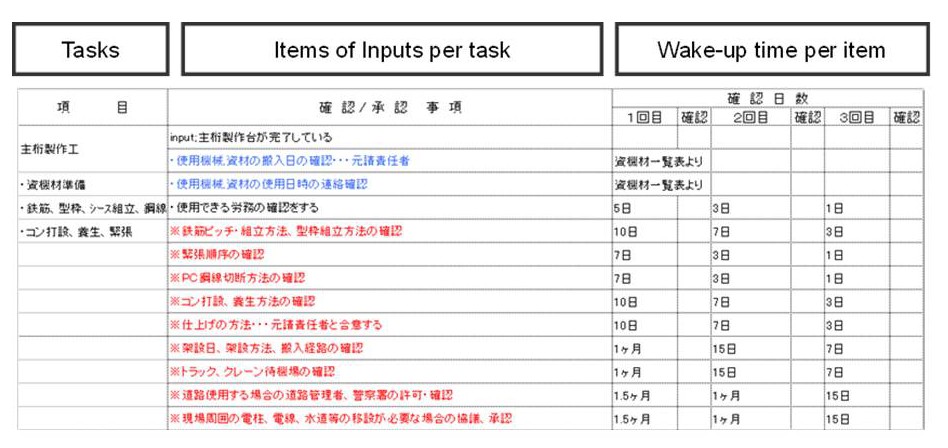
Figure 7: The actual lists of inputs

Figure 8: The actual lists of inputs
[P-8] Determine a wake-up time for each input.
Figure 6 shows the actual lists of inputs. In general, a project leader checks 3 times per each item.[P-9] After finishing [P-6] and [P-9], complete creating the project plan.
The general manager receives the project plan created by the project leader and makes “Decision Flow” decisions as follows:
[P-10] Make a decision whether the project lead-time will meet the target due date or not.
[P-11] If not, perform an adjustment according to the guideline as follows:
- Offloading available?
- Parallel-performing available?
- Additional resources available?
And so on…
After that, back to check the lead time [P-10], again.
[P-12] If yes, determine the time of starting the project.
A project leader receives the project plan approved by the general manager, and communicates with a project manager following “Information Flow”:
[P-13] To have a meeting with a project manager (the client) about the project plan.
[P-14] A project manager makes a decision whether or not he agrees on the plan.
If not, back to creating the project plan [P-1], again.
[P-15] If yes, a project leader goes to the site on the agreed upon start date.
Every project leader shares the quality project plan through the quality check process according to the above planning procedures. Due to this procedure, every project leader has a good working collaboration with their general manager. As a result, every project leader has confidence in their project plan. And, as a good project plan makes the meeting with a project manager more effective, communications with the client are improved.
Execution and Control Phase
Figure 7 shows a part of the procedure for assigning priorities to tasks/inputs/projects, allocating resources and taking recovery actions.
A project leader keeps track of the progress of “Information Flow” as follows.
[E-1] Ask workers for the remaining duration estimate, check the list of inputs.
[E-2] Check whether the item is available or not.
[E-3] If yes, put the check mark “OK” on the list.
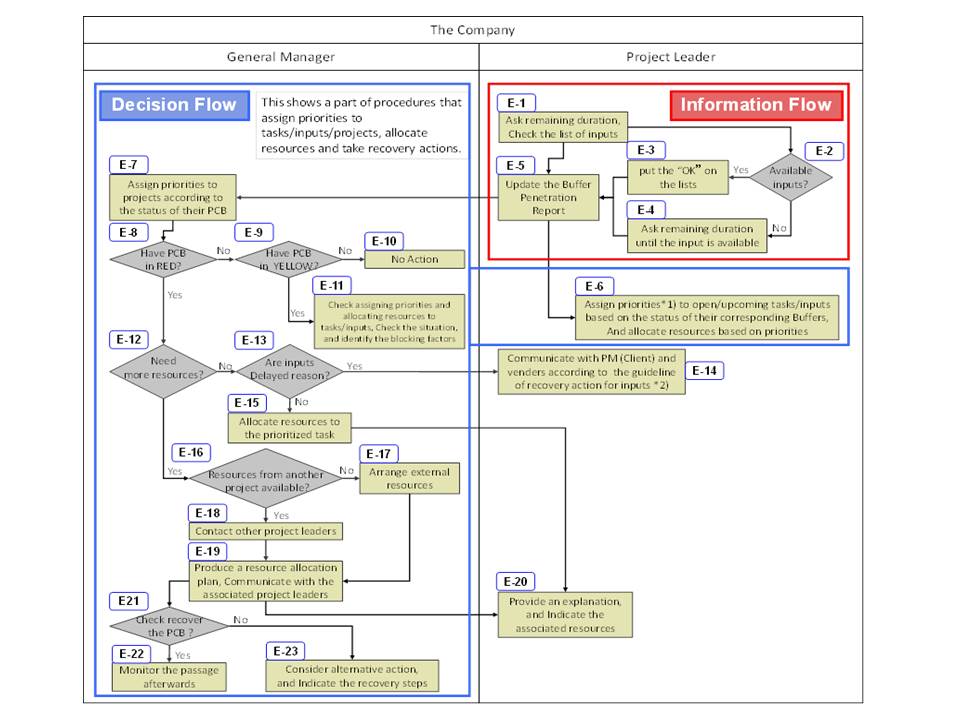
Figure 9: A part of procedures in the execution and control phase
[E-4] If not, ask the vendors and/or the project manager for their remaining duration estimate until the input is available.
[E-5] After finishing [E-1, 3 and 4], update the Buffer Penetration Report.
After that, a project leader makes a decision on his project according to “Decision Flow” as follows:
[E-6] To assign priorities to open/upcoming tasks and inputs based on the status of their corresponding Buffers status according to the guideline,
- To give a top priority to the task/input penetrating into the PCB –Project Completion Buffer.
- To prioritize other tasks/inputs according to the percentage of penetration into the corresponding FBs.
- And allocate resources based on priorities.
Meanwhile, the general manager receives the Buffers Status Report from all project leaders three times per week, and makes a decision according to “Decision Flow” as following:
[E-7] Assign priorities to all projects according to the status of their PCB.
[E-8, 9] Check what the status of PCB is.
[E-10] If the status of PCB is GREEN, do not take any actions.
[E-11] If the status of PCB is YELLOW, check assigning priorities and allocating resources to tasks/inputs, check the situation, and identify the blocking factors.
[E-12] If the status of PCB is RED, make a decision to put more resources.
[E-13] If more resources are not needed, check whether inputs are delayed or not.
[E-14] If yes (inputs are delayed), a project leader must discuss the situation with a project manager (Client) and vendors according to the guideline as follows:
The project leader arranges:
- To negotiate with vendor again.
- To request partial delivery.
- To change to another vendor.
And so on…
[The project manager (client) arranges:]
- To report current status of the progress and discuss with the project manager about recovery actions.
[E-15] If not (inputs are not delayed), allocate resources to the prioritized task, and provide clear direction to the project leader.
[E-16] If yes (more resources are needed), check whether or not more resources are available from other projects.
[E-17] If not (resources from other projects are not available), arrange for external resources.
[E-18] If yes (resources from other projects are available), contact the project leader.
[E-19] After that, produce a resource allocation plan, and communicate with the associated project leaders.
[E-20] Each project leader receives a clear direction [E-15, 19] from the general manager. An explanation is provided and the associated resources are identified.
On the other hand, the general manager checks as follows:
[E-21] Check whether the status of PCB is recovered or not.
[E-22] If yes continue to monitor the passage afterwards.
[E-23] If not, consider alternative action and indicate the recovery steps.
In the execution and control phase, according to the procedure, every project leader is able to have appropriate support such as checking the priority of tasks/inputs and recovery action from the general manager whenever needed. Then, every project leader has good collaboration with the general manager. As a result, every project leader has confidence about the management of their own project. And, they are able to gain the trust of the project manager.
- Results
Subjective assessment
We interviewed all of the managers of the company about the changing points according to a comparison between before implementing CCPM – “Before” and after implementing CCPM – “After”. Figure 8 shows the subjective assessments of delivery, costs and quality. Every item is improved.
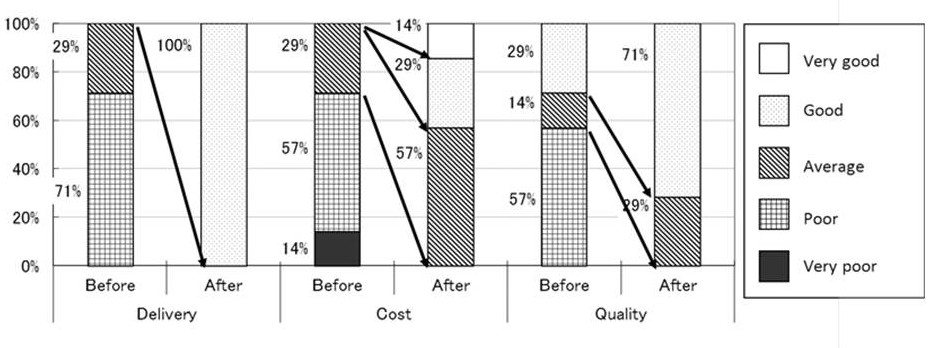
Figure 10: Subjective Assessments
Objective assessment – Operational results
We analyzed delivery and costs according to comparison between “Before” and “After”. The number of “Before” target projects is 17 projects, and “After” target projects is 18 projects. Figure 9 shows the specific operational results of delivery and profit.
We verified DDP (Due Date Performance) and Project lead-time as delivery. Some of the operational results are as following:
- The due date performance improved from 52.9% to 94.4%.
- The average project lead-time shrank from 119 days to 96 days – reduced by 18.3%.
- The gross profit ratio improved from 2.8% to 15.9%.
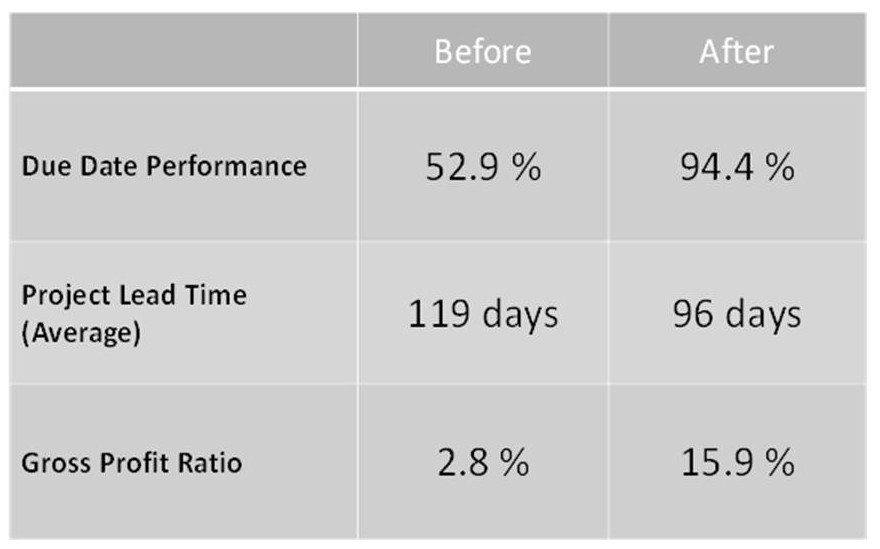
Figure 11: Objective Assessment – Operational Results
Financial result
Figure 12 shows the achieved financial result compared to the industry average. After implementing CCPM, the net profit ratio of the company has been improved year by year from 0.40% in 2006 to 4.35% in 2008. By comparison, the industry average net profit ratio decreased year by year from 0.52% in 2006 to -1.30% in 2008 [11]. The president of the company said that reliability had increased due to improved communication with clients.
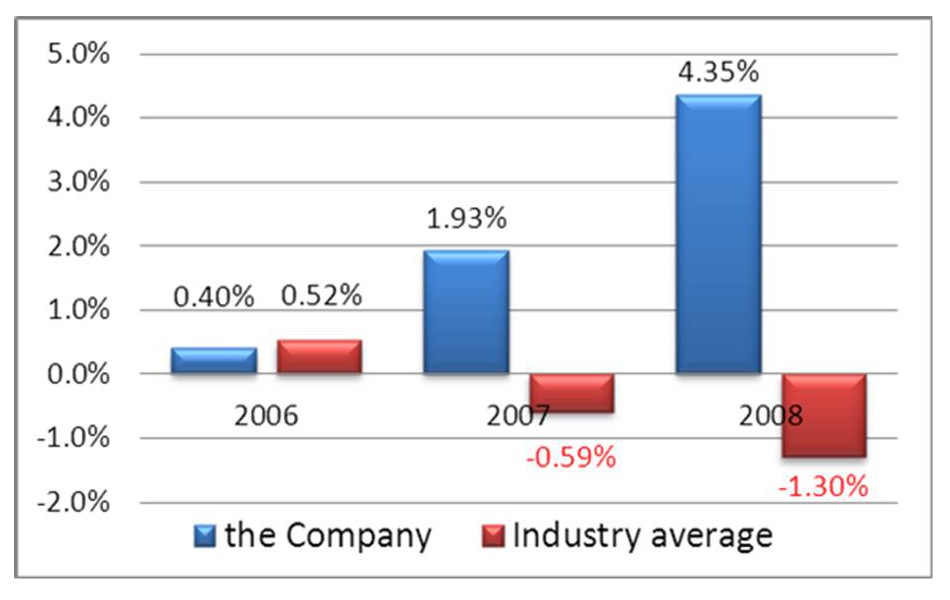
Figure 12: Objective Assessment – Financial Results
- Conclusion
Through the case study, in order to continue the use of CCPM, several important points are noted: The “Information Flow” and “Decision Flow” should be translated into clear procedures with the deployment flow chart. For roll-out of procedures, we have to build a consensus with the relevant people – project leaders, general manager and top management.
The important issue to deal with is the gap and frequent conflicts between the Gemba (frontline managers such as project leaders and supervisors) and top management.. From the Gemba point of view, when they ask the top management to help, they frequently get the answer “do your best”. It leads to Gemba’s mistrust of the management. On the other hand, from the managerial side’s point of view, Gemba always calls for expensive actions. It leads to the managerial side’s mistrust of Gemba.
The Gemba and the top management have the same objective – managing projects better! However, they do not have a way to understand each other’s views, which brings mutual mistrust. Understanding the procedures and guidelines leads to gaining mutual trust.
Basically, project leaders or project managers have a lot of experience and skills to manage projects effectively. However, in some cases project leaders or project managers need support from the upper management. In public works, Gemba and top management are located geographically far from each other. So, it is likely that the top management will have a lot of difficulty providing timely support to the projects under their responsibility. CCPM provides information clearly and quickly from the Process Flow or flow of the project. However, if the management do not give timely support, then project leaders and project managers stop sending the information. It is not due to the lack of the ability of individual managers but due to the lack of tangible managerial procedures and guidelines. Establishing managerial procedures and guidelines are a critical success factor in executing CCPM and ensuring a good collaboration within a company because they create the bridge between Gemba and top management.
Reference
- MLIT(Ministry of Land, Infrastructure and Transport): Prospect of construction investment in fiscal 2010, Outline and the gist, 6
- Research Center for Land and Construction Management, National Institute for Land and Infrastructure Management, MLIT: Guideline for Value Engineering at the Design Phase, 2004.4
- MLIT: Report on the Introduction of Design-Build System into Public Works in Japan, Committee on the Introduction of the Design-Build System, 2001. 3
- Takasaki H., Yamaguchi S., Yuasa Y., Isobe T., Murakami S., Miura T.: A Study on project management applied for civil engineering field, Journal of geological engineering, No.721, pp.153-165, 2002.12
- Research Center for Land and Construction Management, National Institute for Land and Infrastructure Management, MLIT: Interim report about construction management system to support local offices of MLIT, 2006.9
- MLIT : About implementation of One-day Response, 2007.3
- Kishira, Y.: A case study of reengineering public works management at a Japanese government ministry through a “P2M” based program and project management method, ProMAC, 2006.11
- Kochi Prefecture, Public Works Dep.: One-day Response project,4
- Aoyama H.: A case study for Meishi National Highway Office MLIT, Win-Win-Win Public Work International Conference 2008, 2008.11
- Goldratt Schools : Project Management The TOC Way, 2010
- West Japan Construction Surety Co.,Ltd.: Financial data in construction industry in fiscal 2010, http://www.wjcs.net/shihyo/img/keieishihyo.pdf, 2011
All materials available on the TOCPA site are the intellectual property of their authors and cannot be reproduced in any other media and used for any purposes without the prior permission in writing of the authors.
